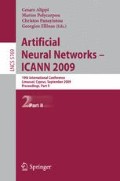Abstract
We demonstrate that selective attention can improve learning. Considerably fewer samples are needed to learn a source separation problem when the inputs are pre-segmented by the proposed model. The model combines biased-competition model for attention with a habituation mechanism which allows the focus of attention to switch from one object to another. The criteria for segmenting objects are estimated from data and are shown to generalise to new objects.
Access this chapter
Tax calculation will be finalised at checkout
Purchases are for personal use only
Preview
Unable to display preview. Download preview PDF.
References
Ahissar, M., Hochstein, S.: Attentional control of early perceptual learning. Proceedings of the National Academy of Sciences 90, 5718–5722 (1993)
Reynolds, J.H., Chelazzi, L.: Attentional modulation of visual processing. Annual Review of Neuroscience 27, 611–647 (2004)
Miltner, W.H.R., Braun, C., Arnold, M., Witte, H., Taub, E.: Coherence of gamma-band EEG activity as a basis for associative learning. Nature 397(6718), 434–436 (1999)
Särelä, J., Valpola, H.: Denoising source separation: a novel approach to ICA and feature extraction using denoising and Hebbian learning. In: Correlation Learning Workshop in the Eighteenth Canadian Conference on Artificial Intelligence, Victoria, Canada, May 2005, pp. 45–56 (2005)
Todorovic, D.: Gestalt principles. Scholarpedia 3(12), 5345 (2008)
Desimone, R., Duncan, J.: Neural mechanisms of selective visual attention. Annual Review of Neuroscience 18, 193–222 (1995)
Usher, M., Niebur, E.: Modeling the temporal dynamics of it neurons in visual search: A mechanism for top-down selective attention. Journal of cognitive neuroscience 8, 311–327 (1996)
Deco, G., Rolls, E.T.: A neurodynamical cortical model of visual attention and invariant object recognition. Vision research 44, 621–642 (2004)
Itti, L., Koch, C.: A saliency-based search mechanism for overt and covert shifts of visual attention. Vision Research 40, 1489–1506 (2000)
Wang, D.L., Terman, D.: Locally excitatory globally inhibitory oscillator networks. IEEE Trans. Neural Net. 6, 283–286 (1995)
Choe, Y., Miikkulainen, R.: Self-organization and segmentation in a laterally connected orientation map of spiking neurons. Neurocomputing 21(1-3), 139–158 (1998)
Weng, S., Wersing, H., Steil, J., Ritter, H.: Learning lateral interactions for feature binding and sensory segmentation from prototypic basis functions. IEEE Transactions Neural Networks 17(4), 843–862 (2006)
Lessmann, M., Würtz, R.P.: Image segmentation by a network of cortical macrocolumns with learned connection weights. In: Proceedings of Biologically Inspired Cooperative Computing (BICC). Springer, Heidelberg (2008)
Walther, D., Rutishauser, U., Koch, C., Perona, P.: Selective visual attention enables learning and recognition of multiple objects in cluttered scenes. Computer Vision and Image Understanding 100, 41–63 (2005)
Kruschke, J.K.: Toward a unified model of attention in associative learning. Journal of Mathematical Psychology 45, 812–863 (2001)
FastICA: The FastICA MATLAB package (1998), http://www.cis.hut.fi/projects/ica/fastica/
Hyvärinen, A., Karhunen, J., Oja, E.: Independent component analysis. Wiley, Chichester (2001)
Yli-Krekola, A.: A bio-inspired computational model of covert attention and learning. Master’s thesis, Helsinki University of Technology, Finland (2007)
Amari, S., Cichocki, A., Yang, H.H.: A new learning algorithm for blind source separation. In: Advances in Neural Information Processing 8 (Proc. NIPS 1995), pp. 757–763. MIT Press, Cambridge (1996)
Ackley, D.H., Hinton, G.E., Sejnowski, T.J.: A learning algorithm for boltzmann machines. Cognitive Science 9(1), 147–169 (1985)
Author information
Authors and Affiliations
Editor information
Editors and Affiliations
Rights and permissions
Copyright information
© 2009 Springer-Verlag Berlin Heidelberg
About this paper
Cite this paper
Yli-Krekola, A., Särelä, J., Valpola, H. (2009). Selective Attention Improves Learning. In: Alippi, C., Polycarpou, M., Panayiotou, C., Ellinas, G. (eds) Artificial Neural Networks – ICANN 2009. ICANN 2009. Lecture Notes in Computer Science, vol 5769. Springer, Berlin, Heidelberg. https://doi.org/10.1007/978-3-642-04277-5_29
Download citation
DOI: https://doi.org/10.1007/978-3-642-04277-5_29
Publisher Name: Springer, Berlin, Heidelberg
Print ISBN: 978-3-642-04276-8
Online ISBN: 978-3-642-04277-5
eBook Packages: Computer ScienceComputer Science (R0)

